#relatively simple thought process for most of these in terms of typing
Explore tagged Tumblr posts
Text
my silly goofy take on the alien stage pokemon teams that i simultaneously put too much effort into, and none at all :3






#relatively simple thought process for most of these in terms of typing#hyuna is more fire/fightibg honestky i couldny devide#i wanted mizi and suas teams to parallel one another#i wanted sua to be ice but the clefable/gengar parallel was too good#and i gave luka espathra because i HATE her#ivan would absolutely have the emo pokemon#🤏 this close to giving him zoroark but that felt wrong#till got a shiny eevee because its gray like him#hence the shiny sylveon#because not only is it hilarious#but it also parallels mizis#see my genius??? see my autism at work??????#alien stage#alnst mizi#alnst till#alnst ivan#alnst luka#alnst hyuna#alnst sua#pokemon
13 notes
·
View notes
Text
"Nawy what do you MEAN quick-ish 3D render it's got scratches and everything and I thought this was real for a minute!!"
Well, first, thank you very much that was the intention ❤, and second, you see, all speed is relative, and between finding my references, modeling, texturing and lighting, on top of having to learn how to make convincing gems, it still took me quite a few hours. I, however, cut corners everywhere for speed, and I wouldn't put this piece in a portfolio in its current state.
But! for the curious, I thought I could do a simple breakdown of how the witchcraft happens, without using too much specialized language to make it more accessible. In short,

In this case, I’m talking about a 3D model that was textured (colours and stuff) and then lit (lights on!) to make a pretty final picture. The objective is not to make a tutorial, but to put in simple terms what a 3D artist does to make something go from this, to that:
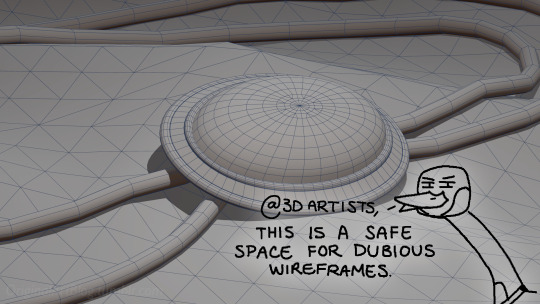

(people curious and/or trying to see if this interests them welcome)
I'm skipping the 3D modeling part altogether, since it isn't where most of the magic happens here. Just know that to be able to add colour and stuff on a 3D object, you have to go through the process or "unwrapping" it, which is like doing those foldable cubes in reverse
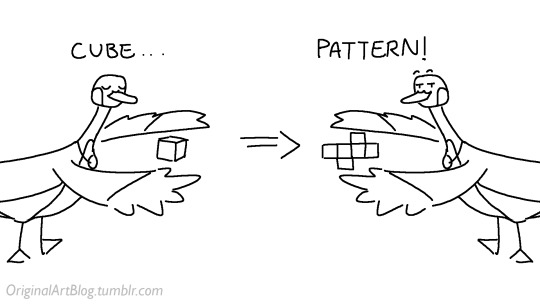
and then we can draw on it!!
Now, the good stuff:
Surfaces (metal, plastic, fabric, wood, skin, etc.) have different looks that make you able to differentiate them on sight. To make something look realistic, you have to try to replicate real life into the 3D world (duh.)
The software developers took care of the hard part (math and coding), so as artists we can play with the parameters available to make something pretty. What those parameters are depend on which "recipe" we're using. One of the most common "recipes" for realistic results is called PBR: Physically Based Rendering, named that way because it's trying to replicate real-life light physics. In this case, the 4 basic parameters are called albedo, roughness, metalness, and normal.
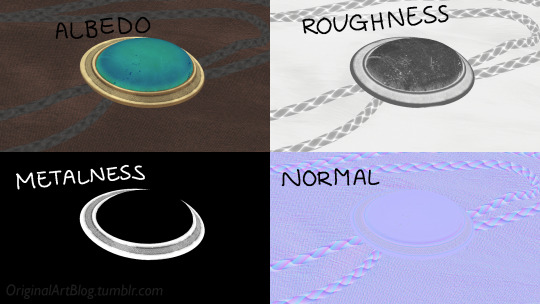
Albedo is the base colour of the surface (easy stuff). Roughness is to determine if a surface is rough or shiny. Metalness is to say if something is made out of metal or not. The normal is there to add all those tiny details you don't want to or can't sculpt on your 3D model (engravings, fabric bumps, etc.)
The roughness and metalness are black and white images because the information you're giving to the software is black = no and white = yes. It's easier to understand in the metalness image, where everything that is NOT a metal is black, and everything that IS a metal is white.
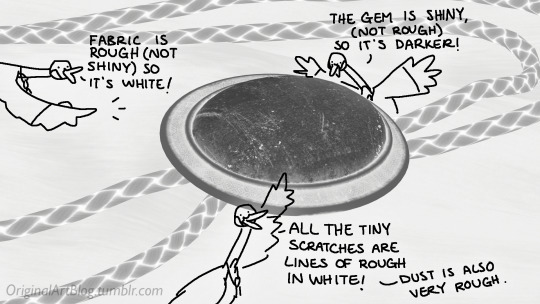
The normal is a bit more complex, but in short, it uses the colours green and red to know what is up/down or left/right, and will help the software fake relief on top of the model. You don't make it by hand; it's computer-generated from other stuff I'm not getting into.

With the technical stuff out of the way, we can actually use these. There are specialized softwares that will let you preview the results of each parameter in real time, so you can see what you're doing easily. This is what I have.
That software comes with some types of surfaces that are already set up, like the fabric in my piece, which was already 85% good for me straight out of the box. Then, it's up to me to use the tools available to decide how shiny a surface is, if there's dust or scratches and where, what colours things are, if there's metal parts, etc. That's where you can see a 3D artist's skills.
And finally, you bring it all together into a specialized software that can render 3D stuff and use those images on the corresponsing parameters, and then light the scene.
Because it all comes down to this: the light! For something realistic, light is vital to get right. You can pour your heart and soul into those tiny scratches, but if you don't light the scene correctly, well...
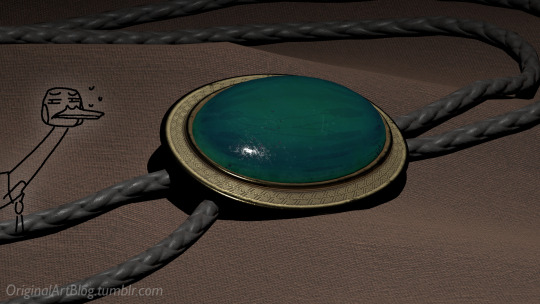
So we carefully light the scene to get some nice highlights to make the textures look good and highlight our subject (it's basically a photography studio inside a computer)
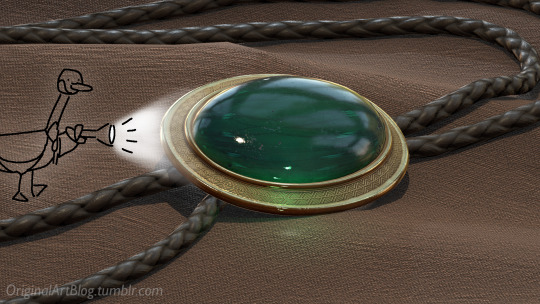
And then we add some camera effects...

and voilà! pretty picture!!
... and if you somehow did notice something different with the bolo tie from my last post, I did find out while taking all these screenshots that I messed up my initial renders in a way that made everything darker than it was supposed to be and that's why my gold looked so muddy...

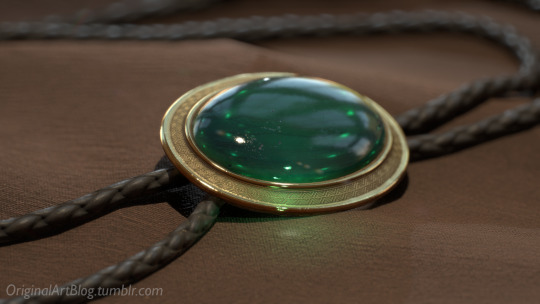
I hope this was interesting and that you learned a thing or two!
#welcome to nawy's 3d school for complete beginners#nawy's 3d#technically not art but... you know...
370 notes
·
View notes
Note
heyy! i hope you’re doing well :) i was wondering what do you think bts would be like courting someone? e.g making CDs, or writing love letters or giving just cute simple dates. more romantic gestures or more simpler / practical ones?
and how long do you think they would court someone until they give up💀(if they do lmao). also i love ur writing :)) 🧡💜
Hello! I am doing excellent, thank you. And I'm glad to hear you enjoy my writing! I often get demotivated, but knowing that there are people out there who actually read my content makes me want to keep going :) Here is my take on this prompt:
How BTS would court someone

V - It would take Tae quite a while to develop feelings for someone that are beyond surface level (and I don't think he would approach someone unless he feels a strong emotional pull towards them). However, the hopeless romantic that he is, he would be relentless when it comes to winning over his crush's affection. He would definitely be the type to deliver flowers to her work or home on the regular (by hand), or show up at her house spontaneously to ask for an impromptu date. He might also try to impress her with his creative side by taking her to a pottery/painting class or playing his beloved saxophone for her. While I think he would be relatively persistent and not be quick to give up, he might lose interest or motivation if she does not reciprocate after a while.
Jungkook - It wouldn't take much to fall for Jungkook for most people (because look at him) but I have a feeling he will end up falling for a girl one day that is completely uninterested in him and his fame. In this case, he would become completely tunnel-visioned towards winning her over. All the romantic gestures - offering to take her on fancy dinner dates, inviting her to watch rehearsals/shows backstage, driving around the city in his Mercedes, buying her a pair of luxury shoes - anything flashy to impress her. I think he would be so blinded by the fact that that he likes someone so much and be inclined to skip the "get to know you phase" completely. I don't think he would be unreceptive to feedback, though; if he senses that she's uncomfortable, he'd probably back off a little and take things slower.
RM - Namjoon wouldn't be very likely to court someone "officially", as he would prefer to observe and learn first. He would start by getting to know her very slowly and gradually, maybe slipping out a witty compliment or two to peak her interest. When he's ready to pursue a relationship, he might gift her something small but thoughtful like a plushie that she admired in a store alongside a handwritten note, or a delicately selected music playlist based on her tastes (I truly see gift giving being his love language). If she's an intellectual, he would want to impress her by reading up on a topic she's interested in or by having a deep conversation. He definitely would not go overboard in fear of scaring her away or making her uncomfortable. He also would disengage immediately if she gave him the slightest hint that she wasn't interested, not because he gave up, but because he's a gentleman who respects people's boundaries.
SUGA - Not much of a courter at all. It's much more likely that someone would approach him first, or that a long-term friendship would evolve into a relationship gradually. His version of courting someone, however, would be getting to know all the little things about them, discovering their interests (especially their music taste), and figuring out what makes them happy. This would be all be done quietly, and then shown in subtle ways like making a playlist he thought she would like or joining her in an activity she enjoys (that he may not necessarily care for otherwise). It would be an organic process with someone he has a natural connection with, so there wouldn't really be an opportunity for "giving up"; it would just naturally fizzle out if it didn't work.
Jin - As I've mentioned many times, Jin is a major introvert and doesn't like to expend too much of his energy on other people. However, I don't think he would be lazy when it comes to someone he likes. Like many of the other boys, flowers would be a go to, but likely shipped to her rather than hand delivered because he would get too shy to do it himself. Courting would be a rather slow process, with interactions being more "formal" in the early days, and there would be absolutely no physical touch until the relationship is official. Outings would be traditional and romantic - dinner dates, walks along the river, a drive-in movie theater. If he's really brave he might hold her hand. I actually do think Jin would be very determined when courting someone because he does like to hold that traditional "masculine" role.
j-hope - Hobi would hardly need to go out of his way to peak someone's interest, as his naturally vibrant and positive energy would make anyone fall for him. He's also quite attentive and considerate towards the people he cares about, so I think this would be magnified x10 when he's interested in someone romantically. He might bring her flowers if he's feeling extra romantic, but his displays of affection would mostly be via acts of service like bringing her lunch at work or offering to run errands with her. Although Hoseok is the bougie king himself, he would offer more casual dates like a picnic at the park or a local fair or couples class. I actually do see him being relatively determined in courting her - he would be consistent in trying to talk to her on the daily/asking her on weekly dates. And it's not because he's trying too hard, that's just how he is.
Jimin - Jimin would be the sweetest man alive when he's smitten. He is visibly loving and affectionate, so it wouldn't be difficult to tell when he's interested in someone. He would use a combination of light physical touch, teasing, compliments, lighthearted dates, and maybe small gifts, to woo her. I see Jimin being the type to want to go above and beyond and put maximum effort into showing someone that he likes them, but I also think he would be aware that it might come across as overbearing. He would start with something small, like giving her a bouquet of flowers with a note asking her on a date, and then following her lead based on what she likes from there (by possibly straight up asking what she would like him to do). Jimin is persistent in the sense that he would not give up easily even if one of his plans doesn't go well, but only up to a point where she is comfortable and receptive.
#bts#bts imagines#kim namjoon#kim seokjin#min yoongi#jung hoseok#park jimin#kim taehyung#jeon jungkook#bts rm#bts jin#bts suga#bts j hope#bts jimin#bts v#bts jungkook
68 notes
·
View notes
Text
Chapter 8a - What's Next?
Book masterlist

I broke up with Sid. I felt a little sad about it, but I felt as if I was stuck. There was no newness in the relationship and besides, I like what I have with Raghuvendra.
I know what I have done to Sid is not right. I had slept with Raghuvendra, to get close and, maybe get some more information about the American project that Riya is producing. Maybe, I also felt that if he had found out from somewhere else, he would have left me, so I left him.
There's fun, a little bit of competition but it's healthy, kind of. Hopefully, this one will be different.
I saw Riya and Raghuvendra arguing about something, and she looks pissed. Like it's about to blow.
I hope they resolve it between them.
We took the cab home, and they all crashed at my place. But I felt that something wrong was going to happen, I just didn’t know what.
〰️〰️〰️〰️〰️〰️〰️〰️〰️〰️〰️〰️〰️〰️〰️〰️〰️〰️〰️〰️〰️〰️〰️〰️〰️〰️〰️〰️〰️〰️〰️〰️〰️〰️〰️〰️
The next day

After the catastrophe that was last night, I decided the best way to start a new day was to indulge in my own thoughts and imagination and starting the process of writing the script. And I also must talk about what happened last night with HR, I think. In case that was not clear, I did not go to work today.
I woke up relatively early, washed myself, made myself a cup of tea, and sat in front of the blinking Word document, hoping that imagination comes knocking on my brain, so I can start writing, but nothing.
My brain was so fried that, I couldn’t even formulate a simple sentence. It also didn’t help that my own office is covered in trinkets that I found during my travels, and there is a special place where I left sone of the most important, happy, and painful things stored in that little steel container, hidden away on the top of my wardrobe.
Today, it felt like the memories were calling me again, so that they could wash me again for the umpteenth time. So, I let them.
〰️〰️〰️〰️〰️〰️〰️〰️〰️〰️〰️〰️〰️〰️〰️〰️〰️〰️〰️〰️〰️〰️〰️〰️〰️〰️〰️〰️〰️〰️〰️〰️〰️〰️〰️〰️
After a few weeks

Everyone knew or maybe they assumed that I would let Raghuvendra on my project that the stunt he pulled that night, so HR got notified and that effectively meant that he was out of my project.
While I was nearly finishing the call with HR, I received a text message. I thought it was going to be an update on my Amazon delivery, but it wasn’t.
It was a text from an old friend, a friend that supported me, but I couldn't stay back.
The text asked how was I?
How am I?
To be honest, I…
I couldn’t text them back, so it remained in the cluster that my messages were, unanswered, unseen, and unread.
In the meantime, I got another text and this time it was Ahaana.


After a few minutes, she starts typing again.


After I had sent that last message, I felt faint, so I went to the bathroom to face. After the cool water touched my face, and started dripping on my t-shirt, I felt like my breath was stuck in my throat. How could I say to her that she should move on, when I couldn’t do it myself.
I heard another ping coming off my phone from my office, so I went to check.



After that, he left to go to her and that was the last I heard from them. As for my project, I finally decided that I was going to produce it myself. No external force would be included in here, in terms of producing.
~~~~~~~~~~~~~~~~~~~~~~~~~~~~~~~~~~~~~~~~~~~~~~~~~~~~~~~~~~~~
After a few days

It’s a relatively normal day at the office, except it doesn’t feel like it.
I can sense something is about to happen.
Riya is in her office, working but she seems on edge and fidgety as though she is going to burst.
During lunch, she calls Fatty into the office. I wonder what they are talking about. The discussion seems to have started well; they are both smiling, and Fatty gets offered a glass of water. It looks like Riya is trying to reassure her that there is nothing wrong, yet.
I wait for her to look towards me, but she never does.
Later, I get called to an ad shoot to help, since the original cinematographer got sick suddenly and that took the whole morning.
Fatty left Riya’s office a little shaken up, but she was well.
When we get together for lunch, I see that she is a little fidgety.
“Well, will you spit it out, I can see you vibrating over there!”
“It’s about Raghuvendra...”
“What about it? Actually, I didn’t see him this morning. I assumed he was here, but now that you mentioned it, I didn’t see him.”
“He left.”
“Left? What do you mean, left like left to take a break or...”
“Left like he left the country to get married to his ex”
There was silence, almost deathly silence. And then, chaos.
“What do you mean!!? I mean how is that possible... we were talking a few days ago...how could he do this me.... wait he left to get married... Married!?”
“He went there to get engaged...”
“Does it matter?!!!!”
I didn’t realise that, from the glass window covering a part of her office, Riya was trying to contact Aahana, her “supposed” friend/ acquaintance to confirm that what Aahana told her was the truth.
Following the tragedy that was lunch, everyone got to work. Some were happy, and some were in shock. Kaira was working robotically, and Fatty was trying to get to talk about her feelings.
At the end of the day, she was also going to get another nasty surprise and this time, the landlord was going to deliver this.
The landlord tells her to vacate her apartment because the building association wants to rent apartments only to married couples.
With all the support from her friend and her irritating call from her mother, she packs her bags to go home, in Goa.
Within her thoughts, she said: “What’s next!?”
Go to Chapter 9
#writing prompts#otp prompts#writing#writeblr#imagine your otp#prompts#otp writing#shah rukh khan#shahrukhkhan#shah#shahrukh#shahrukh khan#red chillies entertainment#alia bhatt#hope entertainment#hope you enjoy#mentalheathawareness#mental health#mental illness#dear zindagi
3 notes
·
View notes
Text
Epidemiology is a very useful study when properly applied in all medical and health care fields. According to the World Health Organization, epidemiology is the study of the distribution and determinants of health-related states or events (including disease), and the application of this study to the control of diseases and other health problems. Various methods can be used to carry out epidemiological investigations: surveillance and descriptive studies can be used to study distribution; analytical studies are used to study determinants." In more simple terms, epidemiology looks for causes. Medicine and health care treatments appear to be lacking in this particular area of study. Risk factors and symptoms are often substituted for causality within medicine, delaying the healing process if addressing it all. While treating symptoms and risk factors becomes very economically beneficial to the for-profit medical complexes of the world, this approach fails the patient at many levels. Epidemiology, which seeks to find causes should not be dismissed and marginalized as a complicated term and thrown away. Medicine and health care treatment stands to benefit at an enormous level if this collective field became serious and honest in their approaches to healing and treating those who have fallen ill. It appears that most health care workers are not really interested in root causes of problems and seek to take profitable and easy routes to healing. Each person is unique and comes from a unique set of circumstances. Causality cannot be generalized to the point as it is today. America is largely full of sick people navigating their lives with chronic illness. These disturbing trends suggest, to me at least, that causality and epidemiology is being ignored at some primitive and obvious level that no one likes to talk about. As long as for-profit health care systems are available, root causes of diseases will most likely be ignored. References. "Epidemiology." World Health Organization. Viewed 13 April, 2013. Retrieved from http://www.who.int/topics/epidemiology/en/ 2. Qualitative research, and qualitative understanding, is very useful in translating certain ideas into words that can be more readily understood by the researcher. Quality is understood as a subjective term and by trying to model quality into a form that can be translated mathematically allows this type of data to be manipulated and crafted to fit certain arguments. Descriptive terms such as good and bad are relative terms and qualitative analysis seeks to standardize these terms in order to communicate their understanding of these terms to more complex and mathematically-based languages. Oftentimes researchers will use qualitative words, phrases and meanings and somehow translate them into numerical data that then can be processed and put through the statistical wringer. The human condition works with both qualitative and quantitative aspects within the brain. Focusing too much on one side of the equation will most likely cause problems and trouble understanding the total picture. Balance is key in this equation. Only when quality and quantity are melded together in a harmonic fashion, can we see the true advantage of modeling our understanding of the world on this type of research. 3. Qualitative research is important in public health because it attempts to create a language or means of understanding that links subjective thought to objective thought. Health is all about "feeling good" and energized. These words mean so many different things to so many different people. Qualitative analysis is mandatory in order to successfully grasp ideas of wellness into a standard and more general understanding. Qualitative research must be incorporated with solid quantitative analysis to complete the circle and make honest and reasonable arguments that can be used to help health care workers to maximize their time and resources into healing and care taking. https://www.paperdue.com/customer/paper/epidemiology-is-a-very-useful-101126#:~:text=Logout-,Epidemiologyisaveryuseful,-Length2pages Read the full article
0 notes
Text
How to Use Gaana to Boost Your Brand and Get More Exposure
In today's crowded digital world, content creators are constantly looking for ways to get noticed. Whether you're a musician, an artist, or a video creator, the key to growing your brand is visibility. One of the best platforms to achieve this is Gaana. As one of India's leading music streaming apps, Gaana not only helps artists get their music heard but also provides video creators with an exceptional opportunity to showcase their content to millions. If you want to boost your brand and gain more exposure, uploading your video on Gaana is one of the smartest moves you can make. This article will guide you through how to use Gaana effectively to enhance your brand’s visibility and expand your audience.
Why Gaana Is a Great Platform for Content Creators
Gaana is widely recognized as one of India's top music and video streaming platforms, with over 200 million active users each month. This makes it an ideal space for content creators to gain massive exposure. The platform is used by people across all age groups and demographics, particularly young adults and music lovers. This wide reach means that your video is not only likely to be viewed by a large audience but also by the right audience—people who are already interested in the type of content you produce.
The success of Gaana lies in its personalization. With machine learning algorithms, Gaana tailors recommendations to individual users, ensuring that they are shown content relevant to their interests. This provides an opportunity for your videos to be discovered by those most likely to engage with your work.
Getting Started: How to Upload Your Video on Gaana
Before you can start reaping the benefits of exposure on Gaana, you need to upload your content. While it may seem intimidating at first, the process is relatively straightforward. Here’s a step-by-step guide on how to upload your video and make the most out of the platform:
1. Create a Gaana Creator Account
To upload your content, the first step is to create a Gaana Creator account. This is different from a regular user account, as it provides you with the necessary tools to manage your videos and track their performance. To create an account, simply visit Gaana’s official website or open the app and follow the instructions for setting up a creator profile. This account will serve as the hub for all your content on the platform.
2. Prepare Your Video for Upload
Before uploading, it’s important to prepare your video in a way that maximizes its visibility. A well-thought-out video will naturally attract more attention. Here are some tips to ensure your video performs well on Gaana:
High-Quality Content: Gaana is a platform where users expect high-quality content, both in terms of visuals and audio. Make sure your video is crisp, clear, and professionally produced.
Appealing Title and Description: The title of your video should be catchy yet informative. It should include keywords related to your content. Similarly, your video description should be optimized for SEO, describing what the video is about and including relevant keywords.
Thumbnail: A visually appealing thumbnail is essential. It’s the first thing that viewers will see, so make sure it represents your video well and stands out.
3. Upload Your Video
Once your video is ready, log in to your Gaana Creator account and navigate to the Upload Section. Here, you will be asked to fill out the necessary details for your video, including the title, description, tags, and category. Choose a relevant category for your video (e.g., music, entertainment, or education) to ensure it’s shown to the right audience.
The process of uploading is simple: click on the “Upload” button, select your video file, and submit the information. Make sure that your video complies with Gaana’s content guidelines, as inappropriate or copyrighted material may be removed.
How Gaana’s Algorithm Helps You Get Exposure
Gaana’s recommendation system is one of its most powerful features, making it a fantastic platform for gaining exposure. The algorithm works by analyzing user preferences, behavior, and viewing habits to recommend content that matches their tastes. This means that when you upload your video, there is a good chance it will be recommended to users who enjoy similar content.
1. Personalized Recommendations
Gaana’s algorithm doesn’t just recommend videos based on popular trends; it also takes into account individual preferences. This means that if your video is about a niche topic but is engaging and well-produced, it can still be recommended to the right audience. The more relevant your content is to the interests of the users, the higher the chances of it being featured on their home page or in their personalized recommendations.
2. Playlist Inclusion
Gaana frequently curates playlists based on specific genres, moods, and activities. If your video fits into one of these playlists, it can experience a significant boost in visibility. Videos that are added to playlists are automatically shared with users who are already interested in that type of content, which increases the chances of gaining engagement.
3. Trending Content
Gaana often highlights trending content on its homepage. Videos that gain traction quickly can make it to the “Trending” section, where they get the most exposure. To increase your chances of appearing in this coveted spot, you need to focus on creating content that resonates with your audience and encourages engagement.
Monetization: Earning Through Exposure on Gaana
One of the most appealing aspects of uploading your video on Gaana is the ability to monetize your content. Gaana offers creators multiple revenue options, including ad revenue, which can be a great source of income as your exposure increases. Here’s a look at how you can make money from your videos:
1. Ad Revenue Sharing
Gaana’s monetization program allows creators to earn money through advertisements shown during their videos. As your video gains views and engagement, it will attract more ad revenue, which is shared between you and Gaana. This is a great way to earn passive income as your video gains more traction.
2. Subscription Models
For creators who have a substantial following, Gaana offers a subscription model. Through Gaana’s premium subscription services, creators can offer exclusive content to paying subscribers. This allows you to build a loyal audience while generating income from premium content.
Engagement Features on Gaana to Build Your Community
Uploading your video on Gaana is just the beginning. To truly boost your brand, you need to engage with your audience. Gaana provides several features that can help you foster a community around your content:
1. Comments Section
Encouraging viewers to leave comments is a great way to start conversations and engage with your audience. Responding to comments helps build a relationship with your viewers, showing that you care about their opinions. It also keeps your audience coming back for more content.
2. Social Sharing Features
Gaana allows users to share videos on other social media platforms like Facebook, Twitter, and WhatsApp. This feature is incredibly valuable as it helps extend the reach of your video beyond the Gaana platform. The more your video is shared, the more exposure it gets.
3. Cross-Promotions with Other Creators
Gaana also allows for collaborations between creators. Partnering with other creators can expand your reach and introduce your brand to new audiences. Collaborations could be anything from featuring another creator in your video to promoting each other’s content. These collaborations are often a win-win for both parties, increasing exposure and engagement.
How to Track Your Performance on Gaana
One of the advantages of uploading your video on Gaana is the detailed analytics it offers. Gaana provides insights into how well your videos are performing, helping you make data-driven decisions about your content strategy. You can track metrics like views, likes, comments, and shares to understand what’s working and what isn’t.
1. Audience Insights
Gaana’s analytics tools provide information about the demographics of your viewers, including their age, gender, and location. This helps you tailor your content to meet the needs and preferences of your target audience. For example, if you notice that most of your views come from a specific city or state, you can customize your future content to appeal more to that audience.
2. Engagement Metrics
By tracking likes, comments, and shares, you can gauge how well your video resonates with your audience. High engagement typically means that your video is being shared with others, increasing its chances of going viral.
Conclusion:
Uploading your video on Gaana is a powerful strategy to get exposure and boost your brand. With a massive user base, sophisticated recommendation algorithms, and monetization opportunities, Gaana offers a unique platform for creators looking to expand their reach. By following the steps outlined in this guide and leveraging Gaana’s features, you can ensure your content gets the visibility it deserves and grows your brand.
Related Articles:
For further reading, explore these related articles:
How to Upload Your Video on iTunes for Free
How to Upload Your Video on iTunes in India: A Complete Guide
How to Upload Your Video on iTunes Globally
How to Upload Your Video on iTunes Step-by-Step
For additional resources on music marketing and distribution, visit DMT Records Private Limited.
0 notes
Text
Beat Drug Tests - The Certo Detox Method to Success!

When it comes to detoxification, many people turn to various products and methods to help cleanse their bodies of toxins and impurities. One such product that has gained attention is certo detox . Often associated with a specific, short-term use to assist with drug testing, Certo detox is a popular remedy among those seeking a quick way to clear their system. However, its use and effectiveness have raised questions about its true potential for overall detoxification.
In this comprehensive blog, we will dive into what Certo detox is, how it works, and whether it is a reliable solution for detoxing your body. Additionally, we’ll explore some of the benefits, risks, and considerations that come with using Certo as a detox method.
What is Certo Detox?
Certo is a brand of liquid fruit pectin, commonly used in making jelly or jams, but it has also gained notoriety as a home remedy for detoxification. The process of detoxing with Certo typically involves drinking the liquid pectin along with a combination of water and other ingredients to help flush out toxins from the body, particularly in situations where individuals are attempting to pass a drug test.
Certo Detox is primarily known for its use in masking the presence of THC or other drugs in urine for a short period. Some people claim that consuming Certo, along with large amounts of water, helps to cleanse the body temporarily, making it easier to pass a drug test. The idea behind this is that the pectin in Certo binds with toxins in the body, allowing them to be flushed out more quickly through urination.
How Does Certo Detox Work?
The basic concept behind certo detox is relatively simple. The fruit pectin in Certo is a type of fiber that can bind with certain substances in the digestive system. When consumed, the liquid pectin is believed to interact with toxins, including drug metabolites, helping to trap and remove them from the body. This process is thought to temporarily lower the concentration of toxins in the urine, allowing individuals to pass drug tests with a cleaner result.
Certo detox usually involves consuming the following:
Certo liquid fruit pectin (about 1-2 pouches)
Water (to help flush out toxins)
Lemon or other acidic substances (sometimes included to enhance the detox process)
The idea is to consume the Certo mix a few hours before a drug test to give it time to work. People typically follow up with drinking plenty of water to aid in flushing out toxins.
Benefits of Certo Detox
Temporary Detoxification:The most popular use of Certo detox is for individuals attempting to pass a drug test. Its effectiveness lies in its ability to temporarily dilute the urine and mask the presence of drugs, particularly THC. When used correctly, Certo detox may help users avoid detection in urine tests.
Natural Ingredients:Certo is made from fruit pectin, a naturally occurring substance. This makes it a more "natural" option compared to synthetic detox products, which may contain harsh chemicals or unknown ingredients.
Quick and Easy Process:Certo detox is relatively simple to use and requires minimal preparation. For those in a pinch, the simplicity and convenience of Certo as a detox method make it an attractive option.
Digestive Support:Fruit pectin is a source of soluble fiber, which may have mild digestive benefits. While Certo is not a dedicated digestive supplement, some users claim that it helps support bowel regularity and may improve gut health when consumed over time.
Risks and Considerations
Temporary and Inconsistent Results:While Certo may help mask toxins temporarily, it is not a guaranteed method for passing a drug test. The effectiveness of certo detox can vary based on factors like body composition, metabolism, and the amount of toxins present in the system. There are no scientific studies that conclusively prove Certo’s effectiveness in drug testing situations, so it’s important to approach its use with caution.
Unproven Detoxification Claims:Certo detox is not a scientifically validated method for overall detoxification. While it may help temporarily dilute toxins for a short period, it does not provide long-term cleansing benefits. The human body already has natural mechanisms (such as the liver and kidneys) to detoxify and eliminate waste, and there is little evidence that Certo offers significant detox advantages outside of the context of passing a drug test.
Potential Side Effects:Some users report mild digestive discomfort, such as bloating or gas, after consuming Certo due to its high pectin content. Additionally, drinking excessive amounts of water in an attempt to flush out toxins could lead to water intoxication or electrolyte imbalances, which can be dangerous.
Ethical and Legal Concerns:Using Certo detox to pass a drug test could lead to ethical and legal issues, especially in professional environments where drug testing is a requirement. It is important to consider the potential consequences of attempting to cheat a drug test, which may include job loss, legal ramifications, or reputational damage.
Is Certo Detox Effective?
The short answer is: it depends. While many users claim Certo detox has worked for them in passing a drug test, the results can be inconsistent. The effectiveness of Certo detox is based on anecdotal evidence and is not supported by scientific research. The product itself is not intended for detox purposes, and its ability to help clear toxins from the body is not conclusively proven.
If you're looking to pass a drug test, Certo detox may offer a temporary solution, but it is far from a foolproof method. Additionally, if you're seeking a genuine detox for health or wellness purposes, there are other more reliable and natural options available, such as improving hydration, increasing fiber intake, and supporting liver function with a balanced diet.
Final Thoughts
Certo Detox may be a helpful, short-term solution for those attempting to mask toxins from drug tests, but it is not a comprehensive or reliable detox strategy. It’s important to approach certo detox with realistic expectations and to fully understand the limitations of this method. If you are concerned about drug testing or detoxification for health reasons, consulting with a healthcare professional or considering more evidence-backed detox methods may be a better choice for long-term wellness.
0 notes
Text
Apply Emirates Visa From Qatar Easily and Quickly 2025

Do you stay or are you a citizen of Qatar and eagerly want to visit these amazing cities and attractions in the Emirates? Apply Emirates visa from Qatar, which has never been that easy! For a more leisurely holiday, a meeting with business partners, or attending a family visit, Emirates visa acquisition is fast and easy.
All you would want to know about an Emirates visa for Qatar residents.
Why Visit the Emirates?
Indeed, it is a land of unforgettable experiences-from towering skyscrapers, luxurious shopping centers, cultural landmarks, and thrilling adventures.
Clearly, the Emirates offers something for everyone, and that's the very reason why it will forever remain one of the most sought-after destinations for travelers from Qatar.
If you are ready to visit then Apply Emirates Visa From Qatar could be the first step towards the exciting journey.
How to Apply Emirates Visa From Qatar
The Emirates Visa application from Qatar is relatively easy. With this application site you can fill in your application without much delay.
The process involves the following simple steps:
1. Determine which type of visa you need: This may be a tourist, business, or transit visa.
2. Fill-up Application Form: Fill up your particulars including passport details and travel details.
3. Provide Required Documents: Upload your scanned copies of essential documents, including your passport and recent photograph.
4. Pay the Fees: The Emirates visa from Qatar cost will depend on your chosen visa type and duration.
5. Wait Processing Upon submission, your application is processed. And you'll have your visa electronically.
Go to [Emirates Visa Online]and it's on to a smooth experience! End
Who is Eligible?
Emirates visa for Qatar citizens: Citizens of Qatar can easily apply for a visa that will take them to the Emirates.
- Emirates visa for Qatar residents: Even the residents holding a valid Qatar residence permit have an entitlement to apply for a visa with minimal requirements.
Emirates Visa Requirements for Qatar
To apply successfully, one should check whether he qualifies for the Emirates visa for Qatar, which includes:
Passport issued is original and valid for six months beyond the entry date.
- Recent passport-sized photographs.
Flight booking to confirm.
- Accommodation proof, such as a hotel reservation or address of the place you’ll stay.
Emirates Visa Categories and Fees
The price of the Emirates visa from Qatar varies with the type and duration you will take. Some of the most popular options are:
- The Emirates tourist visa from Qatar for short-term visits.
- Business and transit visas for specific travel purposes.
An online application is the fastest method to acquire an entrance. Qatar residents can apply for an Emirates visa online using the website and get the process done in a few easy steps.
Benefits of Applying Online
The advantages of applying for your visa using an online platform comprise of
- Rapid Processing: It saves time as an efficient application system.
Convenience: One can apply from anywhere in Qatar without visiting an office.
Secure Payments Provide convenient yet secure means of payment for online purchases.
Discover the Emirates With Ease
An Emirates visa is the key to discover a world of wonders. Explore:
Iconic landmarks such as the Burj Khalifa and all cultural icons. Some exciting activities include desert safaris and water parks. - The poshest hotels, whitest sands, and longest nights. From a solo trip to a family visit or business travel, an Emirates visa ensures that your trip goes problem-free, from booking to landing.
Final Thoughts Emirates Visa for Qatar Passport Holder ; we've made it easy. The process is simple, affordable, and will be saving you time. Start your journey today by visiting.
#apply emirates visa from qatar#emirates visa for qatar citizens#emirates visa for qatar national#emirates tourist visa from qatar#emirates visa for qatar residents#Emirates Visa for Qatar Passport Holder
0 notes
Text
The Beginner's Guide to Domain Flipping: How to Profit from Digital Real Estate
In the vast online business world, domain flipping has emerged as one of the most lucrative yet often overlooked opportunities. It’s like real estate, but instead of buying and selling physical properties, you’re dealing with virtual real estate—domain names. If you’ve ever thought of turning a profit by buying and selling domain names, this guide will walk you through everything you need to know, from understanding the basics to learning how to get started.
What is Domain Flipping?
Domain flipping refers to purchasing domain names at a low price and selling them at a higher price. The goal is simple: buy low and sell high. Like flipping houses or cars, the value of the domain you buy is determined by demand, scarcity, and trends. Some domain names are more valuable than others because they are short, catchy, or tied to a booming industry.
In today’s digital-first world, a good domain name is like beachfront property. Brands are constantly looking for the perfect name that represents their business and appeals to their audience, making domain flipping a potentially profitable endeavor if you know what you're doing.
How Does Domain Flipping Work?
The process of domain flipping involves several steps:
Research and Purchase: You start by identifying valuable domain names that are either available at a low cost or could be bought cheaply from current owners. Tools like GoDaddy, Namecheap, and Sedo provide platforms where you can purchase domain names.
Hold or Improve: Once you have a domain, you can either flip it quickly for a fast return or hold onto it for a while in hopes of its value increasing. Some flippers also choose to "improve" a domain by adding basic websites or increasing its traffic, which can make it more appealing to buyers.
Sell: When you're ready, list the domain on marketplaces such as Flippa, Sedo, or eBay. You can either set a fixed price or let buyers compete in an auction format, driving up the sale price.
Why is Domain Flipping Profitable?
Domain flipping can be highly profitable due to the relatively low initial investment compared to the potential returns. Domain names can be bought for as little as $10, and some have been sold for millions of dollars. For example, the domain "Voice.com" was sold for a staggering $30 million in 2019. While not every sale will be this high, it's not uncommon for domain names to sell for hundreds or even thousands of dollars.
Several factors contribute to a domain’s value:
Length and Simplicity: Short domains are easier to remember and type, which makes them more valuable.
Keywords: Domains containing popular keywords or phrases related to trending industries can command a higher price.
Brandability: Catchy and memorable names that can easily be turned into a brand are often in high demand.
Domain Extension: Domains ending in .com are typically more valuable than other extensions like .net or .org.
How to Start Domain Flipping
1. Pick a Niche
Like any business, domain flipping works best when you specialize. Picking a niche allows you to focus on industries you understand and target domain names that are likely to be in demand. For instance, if you know a lot about technology, you might focus on tech-related domains. The more knowledge you have about a specific industry, the better equipped you are to spot valuable domain names.
2. Research, Research, Research
Before purchasing any domain, always do thorough research. Use tools like Google Trends to identify rising search terms, check the availability of similar domain names, and look at recent domain sales in your niche. The more data you have, the better your decision-making will be.
Keep in mind that domain flipping is competitive, and there are millions of domain names registered daily. Your success depends on being ahead of the curve and spotting valuable opportunities before others do.
3. Buy Low, Sell High
The mantra of domain flipping is to buy low and sell high. Start by registering domains that are either undervalued or likely to become valuable shortly. You can also explore expired domains, which are domains that previous owners let expire and can sometimes be bought at a discount.
As you gain experience, you might also consider buying domains from existing owners. This requires negotiation skills but can pay off if you can buy a domain at a lower price than its market value.
4. List Your Domains
Once you’ve purchased a domain, it’s time to sell. There are many domain marketplaces to choose from, including:
Flippa: One of the most popular platforms for buying and selling domains and websites.
Sedo: A global domain marketplace with a wide range of listings.
GoDaddy Auctions: A well-known auction site for domain names.
You can either set a fixed price or let buyers compete in an auction. Listing your domain on multiple marketplaces can increase your chances of finding a buyer.
Is Domain Flipping Right for You?
While domain flipping can be highly profitable, it's not without risks. Not every domain will sell, and it can take time to see a return on your investment. Additionally, competition in the domain market is fierce, so you'll need to be strategic and persistent.
That said if you're willing to invest the time and effort, domain flipping can be a rewarding way to make money online. It’s a low-cost, high-reward business model that can be done from anywhere, making it an attractive option for entrepreneurs, digital nomads, or anyone looking to generate passive income.
0 notes
Text
Sustainable Furniture: Sabai
Sabai about:
[...] In 2019, [Phantila] Phataraprasit co-founded Sabai—a Thai word that roughly translates to comfortable or relaxed—with business partner and college friend Caitlin Ellen.
[...] “The core of why we wanted to start Sabai is to make sustainable furniture that was accessible to people in our demographic, knowing that we are part of an age group that cares the most about this and wants to purchase according to those values, but are limited by things like budget, lifestyle and convenience,” she says.
Sabai CEO interview:
[Phataraprasit]: [...] We started an Instagram account that served as a great tool to leverage our community to understand what they cared about. When we started the design process, we would always go back to the Instagram community and poll them on, "What do you use your couch for?" "Do you like wide arms?" "Do you like thin arms?" It seems so simple in terms of, obviously, a couch is for sitting, but the insights that we received from that were helpful in informing the design process."
[...] It was definitely difficult for two relatively young women who had never started this type of company before and in a relatively traditional space to find any factory that was willing to work with us and basically take a bet on us. [...] When we finally did find a manufacturer who wanted to work with us, that was amazing, [...], but for us, we [...] had to find the sustainable alternatives to every component of the product so that was definitely a whole process in and of itself.
Sabai Materials blog post:
[...] OEKO-TEX certified hemp fabric is used in our Evergreen slipcovers [...] We wanted to ensure we were using [natural fibers] that uses less water than the cotton and linen options we’ve seen offered.
In place of traditionally used polyester upholstery fiber, we are using a natural fiber material made from a mix of coconut fibers and natural rubber wherever possible. The wooden legs are finished in a water based finish and the frame construction uses a non-toxic, solvent free glue.
[Sabai furniture] are designed to be assembled and disassembled easily with standard hardware and tools. Second, both seating collections are made to be repaired, individual parts can be purchased to replace in case of damage and cushion covers and slipcovers can be replaced to ensure the longevity of the product.
B Corp status of Sabai:
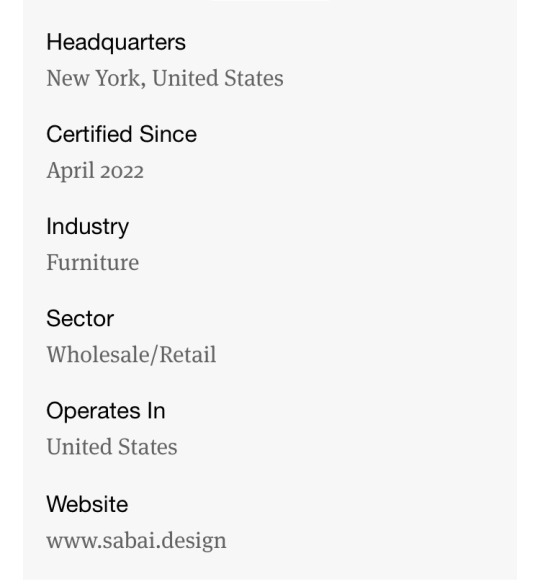
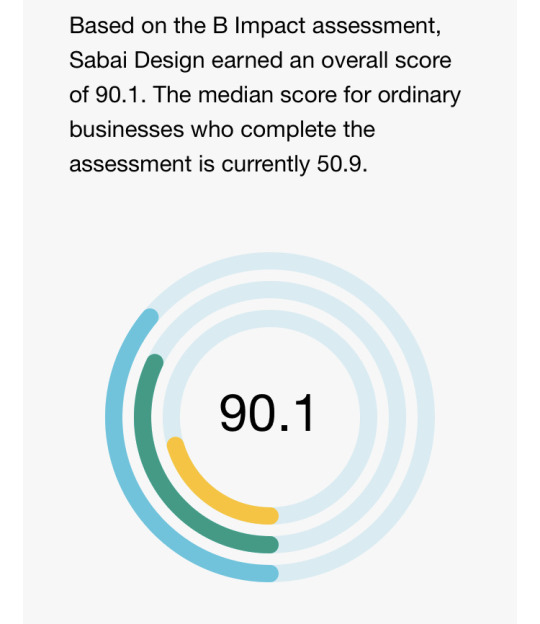
Sabai third-party product review:
#found this while considering shopping for a new couch#i think i might just invest in getting mine reupholstered/framed fixed to extend its longivity but#found this company in my search (for future reference) for sustainable furniture thats not necessarily second hand#my greens#sabai#sabai furniture#aapi#sustainable economy#sustainable furniture#furniture#interior design#non toxic#sustainable industry#women owned business#home health#green link
1 note
·
View note
Text
Installing Shingle Roofing: Key Benefits You Need to Know
Your home's curb appearance and longevity are significantly impacted by the sort of roof you have. When it comes to roofing materials for your house, you have a lot of options. All things considered, shingle roofing is a great way to identify the required roofing level.
Shingle roofs are thought to be found on several homes, and Miami has seen a significant increase in the installation of shingle roofs. Many variables contribute to the elements' immense appeal, such as their relative affordability and their striking presence on most residential buildings. They provide homeowners with options for stylish, long-lasting, and reasonably priced tenting.
Why Choose Shingle Roofing Contactors in Miami?
The degree of complexity:
You may find asphalt shingles in an abundance of beautiful colors to complement your home's exterior design. Imitating slate or cedar sapwood roofing with asphalt is a preferred option. The waterproof asphalt shingles add a rich and elegant elegance to your home. Shingle Roofing Company provides shingle installation services by skilled roofers with extensive technical knowledge to complete the work with pinpoint accuracy.

Simple Installation
Flat roof shingles are easy for homes to maintain, but some roofing components are challenging to fix, confusing both roofing help and the individual owners. Once more, asphalt shingles enable a straightforward installation method that may be adjusted to suit steep or slanted rooftops.
With a shingle roof, repairs are rather easy, which further reduces homeowners' concerns. However, selecting the best Shingle roofing contractors in Miami has to do with moving forward with the installation process; failing to do so could result in serious difficulties down the road with your rooftop.
Diversification
In terms of appearance and distinctiveness, shingle roof designs vary widely. You can choose a uniform, smooth, and clean appearance. If you're looking for something finer, you can also go for projecting asphalt shingles that have a 3D overhung effect and are roughly consistent in contour and shade but mimic conflicting tones.
In addition, shingles with sharp edges and a rustic appearance make a great choice if you want to go with a classical exterior. However, if you're ever unsure about which to choose, you can always contact Miami's Shingle Roofing Company's roofing specialists, and they'll help you make the ideal decision.
Eco-friendly
As shingles can be recycled back into use, they are an environmentally responsible option for roofing. When it comes to quality after conversion, they are more dependable than other materials, such as polymerized replacements, which lose their quality after repeated recycling. Furthermore, only a small number of enterprises have focused on shingle disposal, ensuring that a negligible percentage of shingles end up in the environment.
In order to prevent outside noise and maintain a calm and quiet home, Miami's Shingle Roofing Company offers asphalt shingle cover systems with pitch-dismaying ability. The amount of heat and cold that a house experiences is largely dependent on how well its roof absorbs energy.
Any dwelling needs a cold roof because it ensures that special claims, like heating and cooling, are obtained and controlled by the deflection of daylight and star radiation. Some shingle types retain their reflecting ability while appearing in outstanding shades.

Durable & Economical
Since installing shingles in Miami offers great value for the money, it's a very economical method. Shingle roof contractors also offer financing options and consistent, upfront pricing as rewards for their investment.
As long as they are installed correctly, sturdy, long-lasting shingle roofs won't leak and can last for at least 40 years. The exact balance of shingle systems ensures durability; they are neither unduly light nor unduly heavy.
Shingle roofs are resistant to wind and fire, and they can typically endure the harshest weather conditions.
Guaranteed Happiness
When you use Shingle Roofing Company in Miami, roofing experts, your comfort is guaranteed. The professionals always use the best asphalt stocks and roof placement supplies. To make sure you get the most out of your significant investment, the skilled professional applies meticulous roofing fittings.
Exact Contractors is a leading shingle roof contractor in Miami that provides reliable Roofing, AC, and insulation services for residential areas.
In Conclusion
The colors, patterns, and textures of shingle roofing can differ significantly from one home to the next. Because they are waterproof and may provide a variety of unique roofing looks, the shingles are known as asphalts. Asphalt flat roof shingles are very inexpensive and easy to maintain. If asphalt roofing is done poorly by a novice team, it can be a complete financial disaster.
Make sure you work with professionals from our Miami shingle roofing company if you're considering a domestic shingle roofing system for your home. Here, you can anticipate a trustworthy, affordable quote from the most reputable roofers who are fully committed to their assigned work and complete it as quickly as possible.
#shingle roof contractor#residential roofing contractor florida#roofing contractor miami fl#shingle roof#flat roofing contractors#commercial roofing contractor miami
0 notes
Text
Evaluate Hippocampus’ products and services from a user perspective

Many people have gone to photography and photo shops to take professional photos due to work needs. Now, there are many HE Tuber such offline photo shops, such as Hippocampus. So, what kind of experience can this type of offline give users? In this article, the author combines his own personal experience and talks about the products and services of Hippocampus from the user's perspective. Let's take a look.
Recently, with the needs of work, there has been a need to go to the hippocampus to take professional photos.
Why hippocampus?
Because I have long heard that the photography effects of Haimabo are pretty good, especially for ID photos; and the location of Haima is very interesting. Most other photography and photo shops are open on the street, but he opened in a shopping mall, and there is a shopping mall where I I often go to their place and often pass by their door, so I thought of giving it a try.
Because I consulted when I passed by before, I knew that I needed to make an appointment in advance, so I also made an appointment on the WeChat Hippocampus mini program several days in advance.
Why is there an appointment process?
Because the delivery time of photography services is relatively long, it takes several hours for one customer. Failure to make an appointment may result in long waiting times for customers and chaos on site, resulting in a decline in user experience and reputation.
The product design of Haima is very interesting. It divides a simple photography service into extremely rich segments according to the needs of the crowd and users.
In terms of demand scenarios, there are ID photos, professional photos, marriage registration photos, wedding photos, birthday photos, fairy tale photos, etc.
In terms of user groups, there are children's photos, single photos of boys, single photos of girls, couple photos, friend photos, parent-child photos, family photos, etc.
What I need is men's professional image photos.
I clicked on the page and found that men's professional image photos are divided into three categories according to age groups, namely light chasers, idealists, and top experts. The corresponding ones are young men, middle-aged men, and middle-aged men. The three groups of people have different usage scenarios, industries, and styles. It can be said that they can maximize coverage of user needs while being extremely targeted and accurately meeting user needs.
The price of hippocampal men's professional image photos is not expensive, 399 yuan, which is very popular. But if you look closely, you will find that this is only the price for a single photo. If you want to take multiple photos, I'm sorry, you have to pay extra. Each photo is charged. 120 yuan.
Of course, Haima also provides preferential packages, such as 20% off for choosing 4 extra pictures, 25% off for 6 extra pictures, 30% off for 9 extra pictures; there are also combination packages, such as professional image photo + Get an instant discount of 59 yuan for artistic photos, and an instant discount of 59 yuan for a package of 2 men's image photos.
So what can we learn from Hippocampus’ products and pricing?
First of all, we must set the price threshold of our products as low as possible.
In the environment of cost reduction and efficiency improvement, consumer demand has shrunk significantly. Everyone wants to spend a small amount of money to do big things. If your product is priced too high, customers will not even be interested in getting to know you.
Therefore, the price threshold must be low enough to attract target users first.
Secondly, we must use product mix and additional (value-added) services to increase customer consumption.
Users are attracted, but if they only consume a basic service in the end, there is actually not much money to be made.
For example, a men’s professional image photo costs 399 yuan. After deducting various costs such as makeup artists, services, photographers, post-retouchers, venues, etc., you probably won’t make much money.
However, if the customer chooses two more photos and takes an extra set of artistic photos, then if the cost remains unchanged, these additional consumption will be pure profit.
Finally, there must be VIP services for high-end customers.
There are always some quality-conscious customers who demand higher quality services and are willing to pay higher prices for them.
Therefore, it is reasonable to charge higher prices by providing them with better products and services.
There is also a high-end brand called Hippocampus Master on top of Hippocampus. It also has products for men’s professional image photos, which are also divided into three categories, but the price has become 599 yuan.
Since I didn't notice this high-end brand product when I made the reservation, I didn't experience this product. However, if I were given a chance to choose again, I would definitely choose the 599 yuan instead of the 399 yuan range. In my heart, I would trust the quality of 599 yuan more than the quality of 399 yuan.
I arrived at the store on time at 4:30 pm on Saturday.
First, I checked in and confirmed at the front desk, and then the front desk gave me some product manuals (cases), and then someone guided me to wait next to it.
After waiting for less than 10 minutes, a makeup artist came to me and started applying makeup on me. The make-up artist is a young lady. It can be seen that she has been professionally trained. There is nothing wrong with the make-up, and the service attitude is also good.
The makeup process takes about 20-30 minutes, and then you are taken to the fitting room to change clothes.
The clothes are all provided by Haima, and the selection of clothes is okay. However, because some clothes were sent for washing, the size of the suit I was looking for was not suitable, so I ended up wearing it with a clip for the photo.
I think this link can still be optimized. After all, inappropriate clothing sizes will have a greater impact on photogenic photos.
Then the makeup artist took me to the photography room, where a young lady was waiting with a camera.
We first took a few test shots, and then based on the feedback, the makeup artist fine-tuned my makeup and hairstyle, and then the actual shooting started.
The formal shooting process is also very fast. The photographer will guide me to pose, then take a few pictures of each action, and then it is over. The whole process takes about 20 minutes.
Then there is the selection of photos. I will compare the photos of every angle and action together and choose if I am satisfied with them. If I am not satisfied, I will delete them.
At the end of my selection, I barely chose an extra card as a spare, which meant I paid an extra 120 yuan.
Since I wasn't really satisfied, I changed my clothes and took another set of professional photos.
This time the makeup artist adjusted my makeup and hair style according to my request, and then the process was the same as before, except for one photo in the end.
In other words, for this hippocampus photo shoot, I spent a total of 399+399+120=918 yuan. Since the two professional image photos were packaged, I got a discount of 59 yuan. In the end, I actually spent 859 yuan to get 3 photos.
The entire service process took almost 4 hours, from entering the store at 4:30 pm to leaving at 8:30 pm.
I noticed that during the whole process, there were neither too many nor too few customers in the store. It didn't make people feel noisy and disorderly, nor was it very deserted. It was just right.
When I left the store, I was told that the film would be released the next day, and that I could pick up the photos at the store or download the electronic version online.
Sure enough, the next morning, the WeChat applet of Hippocampus sent me a notification. I clicked on it and found three photos that had been repaired. I made some comments online, and they were quickly corrected. It was okay. Quite satisfied.
0 notes
Text
I don't have ADHD myself (I've likely got some neurodivergency, but nothing official enough to announce to the internet right now), but I thought a bit about your post and might have some ideas that helped me out that you at least find worth pondering.
First, you mentioned immersion, which is fantastic and I'm a massive supporter of early immersion in language learning, but I also wanted to add some immersion concepts which you may already know about. The first is comprehensible input, which basically means that you can understand it with relatively little help from outside dictionaries, etc. This is a great confidence booster, but based on your level, might not be the best way to get you excited about language learning. When I was first starting to read native materials in Japanese, I thought I wasn't ready to read simple manga because everyone kept recommending a series called Yotsuba&. Turns out I could read, I just couldn't force myself through the first chapter of a series that really didn't interest me. The next concept is intensive vs extensive immersion. This is typically used when reading, but can apply to most types of immersion. Intensive immersion is where you focus in on a text with the intention of understanding every single (or most) grammar point and word used. Extensive immersion, on the other hand, focuses on getting the general point of a text and not focusing on understanding each and every minute detail.
As for keeping long term focus on language study, I have multiple methods. One that might help is the structure of attaching studying to an existing routine, since that seemed to help you in the past. For example, when you eat breakfast, perhaps you could watch a grammar video or something.
Another that's currently working spectacularly for me is changing up your surroundings. I'm super late to the cafe study gang, but I've been enjoying it so much, and noticing that my productivity increases compared to when I sit at my desk at home. Additionally, the pomodoro technique (interspersing short breaks into your work time) might be a good pairing here.
Finding a study partner might also be helpful, if just for accountability. If you want to chat with a native speaker of German, there are many language exchange apps such as Tandem, HelloTalk, and Slowly (not specifically for languages, but works well enough). If you've got a friend that may not be learning your target language but maybe studies something else, it might be worthwhile to think about setting up study dates to keep each other accountable. And even if that one day per week or however long is the only time you study your language, that's still more than nothing and that's a win!
This last tip might seem counterintuitive, but I've been doing it for years, so here we go. Switch it up. Severely. I've used so many different methods to track my language learning at this point and all of them have worked in their own ways. One of my favorites was making weekly checklists to guide my studying. This way, I didn't feel bad if I was too busy to study one day and I could also make sure that I wasn't neglecting a specific aspect of my studying in favor of another. Other ways I've tracked my studies have just been taking note of what I do on a given day and in what language. This is a visual cue for me to see, again, where my studying is lacking and what could use some more attention.
Language learning is a very personal process, in that what works for me may not work for you. I hope at the very least I've given you things to consider that helps you find a method that works for you. Viel Glück!
Self-Learning Troubles
I have for a long time had troubles with learning languages by myself. I was doing Duolingo courses for German and the way I was doing them probably contributed to how I was able to maximize my time learning and also maximize my recall afterwards. Back in 2019, I was doing a tech internship and when I would go on my lovely state-mandated breaks (oh how I miss them now that I've moved to a state that doesn't have them), I would take the time to do some German Duolingo lessons (this was before the re-tool to make it more like the CEFR scale, obviously, if that makes a difference; I don't believe it would but this is an aside just for your information; I have digressed, anyway...). Of course, my life has much less structure now than it did then (plus those breaks at work are now non-existence because different state laws so), so I don't think I'd be able to do something similar.
I have since tried to just be a sponge for the languages that I'm learning. Listening to music in the language, attempting to read things in the language, and continuing to say to myself that I'll make a goalpost of trying to take a certification exam for the language that I would then have to study for and eventually hope to pass. I've been looking at said exam for German for a while now, so you can guess how that has gone.
My ADHD and other relevant neurodivergencies make it difficult for me to learn things the normal way, and I don't think there's a way to replicate the way I learned ASL (where I would often watch interpreters and listen to what was being interpreted and attempt to pick up on signs; I have actually attempted to look into this, although the answers that I got were basically "you could try to do it, but I doubt you'll get good results out of it"). Another reason that would be difficult is that I took a class for ASL where we were only allowed to use ASL during lecture hours. That added on the pressure of being graded and since I graduated university two years ago, that definitely won't work.
Tbh I don't know why I decided to write this post. I'd love to be able to study languages daily and make some kind of routine where I could sit down (or probably more accurately, carve time out of my busy work schedule) and practice/learn the languages I'm learning at the time. I feel like I haven't found the right method for me. It's waiting out there somewhere, and I just have to find it. All of the conventional methods haven't worked for me as of yet, so I guess I keep searching.
This is a jumble of word salad, and if you'd like to add a proverbial salad dressing to help me out, feel free. Or don't; this is the free internet, and I have no say in what you do with it.
#i follow my brain a lot in my language learning#like i havent touched my novel in like a month because im exclusively reading horror and 薔薇王の葬列#im also getting back into textbook study after a long time#and cafe studying is helping me so much with that#im also skipping sections in my textbook because i dont feel that they challenge me enough to be worth the time and effort#i think the one thing really worth internalizing is that self studying is not a class#you dont have to do everything 100% by the book#but yes take everything i say ever with a grain of salt because i am me and only you can find what works best for you
38 notes
·
View notes
Text
Memory of Jacques Tati, by Ron Mael

Jacques Tati entered the lobby of the Paris Hilton looking very much like Monsieur Hulot---same raincoat, same determined gait. “Hello, I’m Jacques. You can pronounce it like ‘Jack’.”
When a band is given the opportunity to appear in a film, it usually is a cameo in a prom night scene with adoring teenage actors feigning hysteria at the lip-sync performance of their new song. Here we were, in 1975, being given the chance to make preparations to appear not in an American teen comedy, but in a French film, a Jacques Tati film, and not as a performing band in one scene, but as actors in the entire film with Mr. Tati.
A Swiss record company executive had thought there were similarities in sensibility between Tati’s view of the world and ours. We were under no illusions as to the relative genius of Tati versus Sparks, but we kept our mouths shut and a meeting was set up in the Paris Hilton.
Perhaps Tati, who we doubted had ever heard of Sparks, had accepted the meeting and the inclusion of us in his next film as an attempt to widen his audience. We, of course, never asked him whether it mattered that we weren’t actors. The process began.
Over the next several months, we had numerous discussions with Tati in his Paris office about the planned film “Confusion.” It was to be centered in a television studio with Russell playing a television director and me playing some sort of technician.
We learned that the oft-debated “auteur” theory in film did at least exist in Tati’s world. Attending the meetings were only Tati, his sketchbook and notepad, his personal assistant, and the two of us. Our job during the “collaboration” was mostly to marvel at the brilliance of his ideas, a job made easy by the brilliance of his ideas. Each meeting would typically begin in the French manner of starting a statement with “no”, as in “No. we must be certain we are completely prepared before beginning anything,” in effect contradicting a statement that had never been made.
As the meetings progressed, it seemed as if there was a basic structure in his notebook on which to hang “gags.” I use the term “gags” with some hesitation as these were not modern American comedy-type gags or even silent comedy gags, but more visual playthings or visual puns. A highly decorated military general, wearing numerous colorful battle ribbons on his chest, finds the colors of these ribbons begin to run down his uniform into a pool on the floor. Another character would be shown to leave the frame of the film, much as Tex Avery characters sometimes do, perhaps in order to make you aware that you are in fact watching a film. Jacques, tell us where to stand and we’ll do anything.
Outside of his office, Tati seemed always to be studying peoples’ movements and behavior. He would always take public transport, never a taxi and most certainly never a limousine, in order to be able to watch people and not feel sheltered from the surroundings. Even a lunch at a restaurant would be more than just steack-frites, with Tati asking a waitress what part of the animal a certain cut of meat came from. When she demonstrated and left the table, he would mimic her action, not in a mean-spirited or patronizing way, but in what seemed like the transformation of her simple act into a ballet move.
At one point in the series of discussions in Paris, Tati and Sparks were asked to be guests on a Swedish television show. Tati’s only request of the show was that they supply a white horse for his use during the TV performance as a “prop.” No problem! (Our 25 year long search for a video copy of this performance ended when our recent pilgrimage to the same Swedish television station revealed that copies of the show no longer existed. Tragic). Soon, our meetings with Jacques Tati occurred less and less frequently. Perhaps there were financial problems. Perhaps there were health problems. We never knew. Finally, sometime late in 1975, our meetings stopped.
People in bands are always selfish about one thing or another. My selfishness was wanting to forever be linked in some small way to the brilliance of Jacques Tati. How ironic that after 30 years as a musician, my sole regret is not being able to have appeared in a French film, a Tati film. I will always remember that first Jacques Tati entrance into the lobby of the Paris Hilton and how, in a sense, being in his presence for even a short period of time made me an actor in Monsieur Hulot’s world.
------- Ron Mael
This essay was written by Ron and appears on pages 30-32 of the Guide Book. Paragraph breaks added by me for readability; punctuation/spelling errors are the book’s own. For copyright reasons, I haven’t included the Japanese translation by Tsuzuki Hajime, my apologies.
#Ron Mael#Jacques Tati#I may have shed a tear whilst reading this for the first time and some subsequent times and also when copying it out here#His final sentiment is very lovely#Guide Book
72 notes
·
View notes
Note
If you are accepting requests what about first date headcanons with the RFA (if that is too many characters what about just Yoosung? 😊) hope you have a great day xx
I hope this okay anon!! I added Saeran and V into this just for my own serotonin <3 oh to think about Saeran’s first date~ Reminder that I have a giveaway open!
Yoosung Kim First Date Headcanons
Oh, he is so nervous. He’s never been on a date before, so cutscene to him asking Zen and Seven what he should do: with Zen suggesting that he should be as suave as possible, presenting you with bouquets and chocolates and Seven telling the boy that he should only speak backwards to prove that he was cool. Definitely not trying to just make him look like an idiot.
He’s a poor student, so your first date would be somewhere relatively cheap, most likely the cinema and then go get some food afterwards! Yoosung would believe he had to be chivalrous and let you pick the movie and where you wanted to eat, and would try to pay for your ticket and food since he’s the one who asked you out.
He’ll be internally panicking the entire time in the cinema, wondering whether he was allowed to wrap his arm around you or touch your hand. He really wanted to, but he didn’t want you to think he was moving too fast. So, when you lean your head on his shoulder he swears his heart stops. He won’t move a single muscle for the rest of the movie because he doesn’t want to disturb you.
He’ll try to work up the courage to hold your hand on the walk home and he’ll actually manage it when you’re about two minutes away from where you live. It’s the thought that counts.
Zen/Hyun Ryu First Date Headcanons
On the outside, Zen’s cool and collected. He knows how to flirt and how to look good whilst doing it. He’s had a girlfriend before but that was a while ago, so he would be ever so slightly worried that perhaps he’ll be a little rusty. He spends extra long looking himself over in the mirror making sure that he looks his absolute best before he comes to meet you.
Your date would be an evening in the bar, sharing a couple of drinks and getting to be more comfortable in one another’s presence. Zen’s usually flirty, but he’s even more so after he’s had a couple of beers. He’ll be throwing compliments and winks at you like there’s no tomorrow: but that’s okay because you’re definitely enjoying the attention.
You’ll talk about everything under the sun, the RFA, his work, your hobbies, how much he hates Jumin, how weird funny Seven is.
Zen will make sure you’re into it before he touches you, but he’ll be quick to wrap his arm around your waist or lightly touch your hand, using his finger tips to trace around the inside of your wrist. He won’t admit it, but seeing you so happy for his affection and even reciprocating it flusters him a little because it’s so genuine and sweet.
Zen insists on walking you home, especially because it’s late and he wants to personally make sure you get home safe. He’ll swap between holding your hand and holding you by the waist as you walk, and will kiss your cheek before you go into your house. He doesn’t want to push his luck or overstep any boundaries, he’s a gentleman afterall, but he’s very pleasantly surprise when you pull him in for another kiss on the lips.
Jaehee Kang First Date Headcanons
Jaehee’s also rather nervous before the first date, but tries her best to keep calm. She figures that you wouldn’t have agreed to the date if you didn’t already like her, but she’ll still doubt herself in that you should be with someone more interesting and less plain.
She’ll invite you to a lunch date at her favourite coffee shop, and will enthusiastically explain all the different types of coffee beans and processes to you. Your heart flutters at the sparkle in her eye and she apologises for getting too excited, please reassure her that you love listening to what she has to say.
When you both order and sit down, Jaehee gives you the Zen DVDs she offered to lend you, and the two of you talk about the different musicals and extra behind the scenes, and Zen, and you promise to guard these DVDs with your life.
You listen as she slightly vents about Jumin, which is very understandable and you console her for having to catsit Elizabeth the 3rd once again. Jaehee gets a little bit flustered when you read across the table to hold her hand, but her gentle smile indicates that she’s enjoying the affection.
When it’s time for you to part, after Jaehee got another coffee to go whilst muttering that she just got another two emails from Jumin, Jaehee’s a little hesitant on the appropriate goodbye, she isn’t quite sure what to do since it was only a first date. The two of you hug, and she’’’ be so worried you’ll feel how much her heart is racing.
Jumin Han First Date Headcanons
Pulls out all the stops. You continuously assure him that he doesn’t need to and that you’re on the date to spend time with him, not his money. And whilst he understands that, he wants to treat you to a pleasant first date that you won’t forget and just believes that it should be standard to treat his partner.
He’ll have Driver Kim pick you up and bring you to Jumin’s favourite restaurant, where he’s (Jaehee) made reservations for the two of you. It’ll be an evening meal, shared over a bottle of horrifically expensive wine.
He’ll show you another one of his beautifully captured blurry images of Elizabeth the 3rd. He’ll even offer to show you the livestream he has on his phone, showing you watch Elizabeth was currently curled up asleep on the sofa.
He’s more interested in hearing about you than talking about himself. Jumin doesn’t mean to worry you with his forwardness. He’s very intent on being nothing like his father in terms of dating, and wants you to know that he doesn’t go into anything half-hearted, his lovelife included.
You offer to pay your share, but Jumin declines. He insists that he was raised to pay for his partner’s meal, but he appreciates the sentiment that you were not depending on him to cover your bill, even though he always intended to do so anyway.
You’ll share Driver Kim’s car on the way back, with Jumin taking your hand and kissing it as you left the car, telling you that he had a wonderful time and hoped that you did too, a small smile present on his face.
Saeyoung Choi First Date Headcanons
Seven is very stressed. Firstly, he can’t believe that he even asked you on a date, let alone the fact that you said yes. Who would want to date someone like him? He’s a mess. But regardless, he’s getting himself all worked up and it’s only a slap in the back of the head from Vanderwood that sorts him out.
Your first date would be to an arcade during the evening. You let Seven pick the date, and you laughed when you heard what he had chosen. It was so him: fun, childish, a bit chaotic.
He’s very good on the claw machines, and will make a point of winning you any stuffed animal you want. He’ll also just win any particularly cursed plushies that he sees. This means that you’ll end up with an entire bag of cute stuffed animals, a minion, a bootleg Shrek, a fish with no eyes and a random sock that somehow made it’s way in.
As a joke, you bring the bootleg Shrek up to your lips and kiss it before pressing it against Seven’s lips to also kiss the stuffed toy. His heart is racing and he sends a flustered, very speedy message of ‘ASDFGWESHARED AN INDRECT KIS WITH SHREK!!!’ to Vanderwood, and completely received an ‘I don’t care’ in reply.
The two of you take a selfie to send to the chatroom, and Seven’s heart is fluttering so fast, you’re so close to him and oh god he can even smell your perfume and it’s so nice and- Snap. You took the picture, and laughed at how Seven wasn’t even looking at the camera in the photograph, he was glancing at at you with the softest expression on his face. He’s so embarrassed.
You get a ride home in one of his babies, and once you collect all of your stuffed toys out of the backseat, you root around in the back and give Seven the bootleg Shrek you both kissed. He wishes you a goodnight and turns to turn the radio on after you get out the car. He wasn’t looking at you, so his heart was not prepared for when you planted a kiss on his cheek before promptly running back into your home. Oh. He’s fallen, hard.
Saeran Choi First Date Headcanons
Saeran had never been on a date before, he’d never even had anyone romantically interested in him or been romantically interested in anyone before he met you. There was no way he was going to ask his idiot brother for advice, even though Seven was quite literally begging him to do so. He’d relented to the extent of briefly looking it up online, but nothing seemed quite right.
He’d settle on a picnic and a walk around the park, since it was simple and sweet. He was a little nervous, so hoped that the flowers and sky would calm him down and he’d be able to talk to you about any flowers that the two of you found.
He’d make the picnic food all on his own (letting his brother eat any of the scraps from the preparation) after asking what your favourite foods were. He’s so happy to see you enjoying what he made, it fills him with a warmth he still cannot quite pinpoint, but he knows he wants to feel it again and again.
He’d take your hand in his as you walked around the park, where he could point out the different flowers and tell you their meaning, and how pretty they would look braided into your hair. When the two of you see an ice-cream van, he immediately suggests going over to buy some, and your heart clenches at the sheer childlike joy at getting to eat it. It’s so sweet and tender to watch.
He swears he can see a poof of red hair every now and then from behind a tree, or in the reflection of a shop. Surely not. He must be imagining things. He had better just be imagining it.
V/Jihyun Kim First Date Headcanons
V isn’t particularly picky when it comes to dates, as long as it’s doing something that you would enjoy. If you left it down to him, which you did this time since it was your first date and he was the one that asked you out, it would be spending time together at his house over a bottle of wine. He’s not as formal as Jumin, so he doesn’t mind you coming over straight away. V’s not expecting you to spend the time, so he’s already arranged for one of Jumin’s drivers to come and pick you up afterwards, as a personal favour to Jumin.
Genuinely, V just wants to know more about you. He’ll ask you about your likes and interests, what you hate, how you love, what your world views are, how you see yourself and what art means to you. He’s not a particularly great cook, but he’ll make dinner for the two of you and pour you a glass to go with it.
He doesn’t regard himself as an interesting enough person to warrant your attention, but he’ll answer almost any question you ask him about himself. He’s trying to be a more open and honest person, especially to you. Whilst there are some things he’s tentative to talk about, he’ll freely share his world and artistic views with you.
V will show you some of his photographs, and more intimately his paintings, in his studio and let you see his workspace. He’ll show you around his private collections and, if you’re comfortable with it, will ask to take pictures of you since there’s not enough time to paint you- although he definitely mentions wanting to do that at a later date too.
#mystic messenger#mystic messenger x reader#jumin han#jihyun kim#mystic messenger headcanon#mystic messenger hcs#zen mystic messenger#seven mystic messenger#saeyoung choi#saeran choi#yoosung kim#saeyoung choi x reader#saeran choi x reader#hyun ryu#jaehee kang#mystic messenger self insert#mystic messenger reader insert#jumin han x reader#jihyun kim x reader#yoosung kim x reader
341 notes
·
View notes
Note
🎭 ☯️ ⚔️ + stasia & carly xx
Alright Stella here are your ladies in their psychological profiles!

Temperament: Choleric
Your temperament is choleric. The choleric temperament is fundamentally ambitious and leader-like. They have a lot of aggression, energy, and/or passion, and try to instill it in others. They can dominate people of other temperaments, especially phlegmatic types. Many great charismatic military and political figures were choleric. They like to be in charge of everything. However, cholerics also tend to be either highly disorganized or highly organized. They do not have in-between setups, only one extreme to another. As well as being leader-like and assertive, cholerics also fall into deep and sudden depression. Essentially, they are very much prone to mood swings.
Psychological Archetype: The Warrior
When everything seems lost the Warrior rides over the hill and saves the day. Tough and courageous, this archetype helps us set and achieve goals, overcome obstacles, and persist in difficult times, although it also tends to see others as enemies and to think in either/or terms. The Warrior is relatively simple in their thought patterns, seeking simply to win whatever confronts them, including the dragons that live inside the mind and their underlying fear of weakness. Their challenge is to bring meaning to what they do, perhaps choosing their battles wisely, which they do using courage and the warrior's discipline.
DND Alignment: Chaotic Evil
A chaotic evil character does whatever his greed, hatred, and lust for destruction drive him to do. He is hot-tempered, vicious, arbitrarily violent, and unpredictable. If he is simply out for whatever he can get, he is ruthless and brutal. If he is committed to the spread of evil and chaos, he is even worse. Thankfully, his plans are haphazard, and any groups he joins or forms are poorly organized. Typically, chaotic evil people can be made to work together only by force, and their leader lasts only as long as he can thwart attempts to topple or assassinate him. Chaotic evil is sometimes called demonic because demons are the epitome of chaotic evil. Chaotic evil is the best alignment you can be because combines self-interest and pure freedom. However, chaotic evil can be a dangerous alignment because it represents the destruction not only of beauty and life but also of the order on which beauty and life depend.

Temperament: Sanguine
Your temperament is sanguine. The sanguine temperament is fundamentally spontaneous and pleasure-seeking; sanguine people are sociable and charismatic. They tend to enjoy social gatherings, making new friends and tend to be boisterous. They are usually quite creative and often daydream. However, some alone time is crucial for those of this temperament. Sanguine can also mean sensitive, compassionate and thoughtful. Sanguine personalities generally struggle with following tasks all the way through, are chronically late, and tend to be forgetful and sometimes a little sarcastic. Often, when they pursue a new hobby, they lose interest as soon as it ceases to be engaging or fun. They are very much people persons. They are talkative and not shy. Sanguines generally have an almost shameless nature, certain that what they are doing is right. They have no lack of confidence.
Psychological Archetype: The Jester/Fool
The Fool/Jester archetype urges us to enjoy the process of our lives. Although the Fool/Jester can be prone to laziness and dissipation, the positive Fool/Jester invites us all out to play--showing us how to turn our work, our interactions with others, and even the most mundane tasks into FUN. The goal of the Fool/Jester is perhaps the wisest goal of all, which is just to enjoy life as it is, with all its paradoxes and dilemmas. What causes most dread in the Fool/Jester is a lack of stimulation and being 'not alive'. They must seek to 'be', perhaps as the Sage, but may not understand this.
DND Alignment: Chaotic Evil
A chaotic evil character does whatever his greed, hatred, and lust for destruction drive him to do. He is hot-tempered, vicious, arbitrarily violent, and unpredictable. If he is simply out for whatever he can get, he is ruthless and brutal. If he is committed to the spread of evil and chaos, he is even worse. Thankfully, his plans are haphazard, and any groups he joins or forms are poorly organized. Typically, chaotic evil people can be made to work together only by force, and their leader lasts only as long as he can thwart attempts to topple or assassinate him. Chaotic evil is sometimes called demonic because demons are the epitome of chaotic evil. Chaotic evil is the best alignment you can be because combines self-interest and pure freedom. However, chaotic evil can be a dangerous alignment because it represents the destruction not only of beauty and life but also of the order on which beauty and life depend.
#petition to put Carly and or Stasia in a campaign!#stasia e. oc#carly oc#stasia chara ask#carly chara ask#idk why I felt surprised by the chaotic evil but makes a nice pairing! true love right there :’)#this is what happens when you put an introverted chaotic with an extroverted chaotic it’s just these two trying to run an empire
8 notes
·
View notes